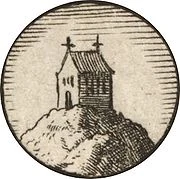
...one holy Church is to continue forever. The Church is the congregation of saints, in which the Gospel is rightly taught and the Sacraments are rightly administered. –Augsburg Confession[1]
The invisible church or church invisible is a theological concept of an "invisible" body of the elect who are known only to God, in contrast to the "visible church"—that is, the institutional body on earth which preaches the gospel and administers the sacraments. Every member of the invisible church is saved, while the visible church contains some individuals who are saved and others who are unsaved. (Compare Matthew 7:21-24.)
This concept has been attributed to St Augustine of Hippo as part of his refutation of the Donatist sect.[2] He was strongly influenced by the Platonist belief that true reality is invisible and that, if the visible reflects the invisible, it does so only partially and imperfectly (see Theory of Forms).[3] Others question whether Augustine really held to some form of an "invisible true Church" concept.[4]
The concept was insisted upon at the Protestant reformation as a way of distinguishing between the "visible" Catholic church, which according to the Reformers was largely corrupt, and those within it who are truly believers. John Calvin described the church invisible as "that which is actually in God's presence, into which no persons are received but those who are children of God by grace of adoption and true members of Christ by sanctification of the Holy Spirit... [it] includes not only the saints presently living on earth, but all the elect from the beginning of the world." (Institutes 4.1.7)
Later Pietism took this one step further with its ecclesiolae in ecclesia.
Roman Catholic theology, reacting against the concept of a purely invisible Church, emphasized the visible aspect of the Church founded by Christ, but in the twentieth century placed more stress on the interior life of the Church as a supernatural organism, identifying the Church, as in the encyclical Mystici Corporis Christi[5] of Pope Pius XII, with the Mystical Body of Christ.[6]
This encyclical rejected two extreme views of the Church:[7]
- (1) A rationalistic or purely sociological understanding of the Church, according to which she is merely a human organization with structures and activities, is mistaken. The visible Church and its structures do exist but the Church is more, as she is guided by the Holy Spirit:
Although the juridical principles, on which the Church rests and is established, derive from the divine constitution given to it by Christ and contribute to the attaining of its supernatural end, nevertheless that which lifts the Society of Christians far above the whole natural order is the Spirit of our Redeemer who penetrates and fills every part of the Church.[8]
- (2) An exclusively mystical understanding of the Church is mistaken as well, because a mystical "Christ in us" union would deify its members and mean that the acts of Christians are simultaneously the acts of Christ. The theological concept una mystica persona (one mystical person) refers not to an individual relation but to the unity of Christ with the Church and the unity of its members with him in her.[9]
For the Eastern Orthodox Church too, making a real distinction between the heavenly and invisible Church, alone true and absolute, and the earthly Church, imperfect and relative, is a "Nestorian ecclesiology".[10]
References[]
- ↑ See Augsburg Confession, Article 7, Of the Church
- ↑ Justo L. Gonzalez (1970-1975). A History of Christian Thought: Volume 2 (From Augustine to the eve of the Reformation). Abingdon Press.
- ↑ Wallace M. Alston, The Church of the Living God: A Reformed Perspective (Westminster John Knox Press, 2002 ISBN 0664225535, 9780664225537), p. 53]
- ↑ Patrick Barnes, The Non-Orthodox: The Orthodox Teaching on Christians Outside of the Church
- ↑ Mystici Corporis Christi
- ↑ John Hardon, Definition of the Catholic Church
- ↑ Heribert Mühlen, Una Mystica Persona, München, 1967, p. 51
- ↑ Pius XII, Mystici Corporis Christi, 63
- ↑ S Tromp, Caput influit sensum et motum, Gregorianum, 1958, pp. 353-366
- ↑ Vladimir Lossky, The mystical theology of the Eastern Church (St Vladimir's Seminary Press, 1976 ISBN 0913836311) p. 186
See also[]
- Augustine of Hippo
- Donatism
- Catholic
- Protestant Reformation
- One, Holy, Catholic, and Apostolic Church